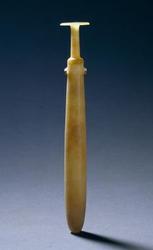Alabaster
Q: What does the alabaster container of perfume signify? I was told that once it was opened and its contents were used on someone, the person who owns the box in turn belongs to the person upon whom its contents were used.
 A: The Gospels refer to something called an alabastron in three verses; see Mark 14:3, Matthew 26:7, and Luke 7:37. In these verses, it means a sealed alabaster flask with a long neck for storing perfume. The neck would be broken off when the contents were used, rendering it unusable in the future. We read how this happened in the Markan account: “While he was at Bethany in the house of Simon the leper, as he was reclining at table, a woman came with an alabaster flask of ointment of pure nard, very costly, and she broke the flask and poured it over his head.”
A: The Gospels refer to something called an alabastron in three verses; see Mark 14:3, Matthew 26:7, and Luke 7:37. In these verses, it means a sealed alabaster flask with a long neck for storing perfume. The neck would be broken off when the contents were used, rendering it unusable in the future. We read how this happened in the Markan account: “While he was at Bethany in the house of Simon the leper, as he was reclining at table, a woman came with an alabaster flask of ointment of pure nard, very costly, and she broke the flask and poured it over his head.”What the ancients called “alabaster” was a banded variety of calcium carbonate deposited from water, as in cave rock formation. By the time of Christ, the word was also used for flasks of this long-necked shape made of any material. In modern times, alabaster refers to gypsum (calcium sulphate), a much softer stone and less suited for the purpose of carrying fine ointments.
I’ve never heard anything about the person bestowing the anointing belonging to the recipient. Perhaps a reader might have some information to add. However, in a personal way, the “wasting” of the container does indicate a special relationship — the contents themselves were quite expensive and then we consider that a specially carved alabaster container was no small expense. Its breaking certainly signified the value the giver placed upon the recipient.
Scripture quoted from The Holy Bible, English Standard Version™, © 2001 by Crossway Bibles.
Send email to Ask the Pastor.
Walter Snyder is the pastor of Holy Cross Lutheran Church, Emma, Missouri and coauthor of the book What Do Lutherans Believe.
Technorati Tags: alabaster | anoint | perfume

0 Comments:
Post a Comment
<< Home